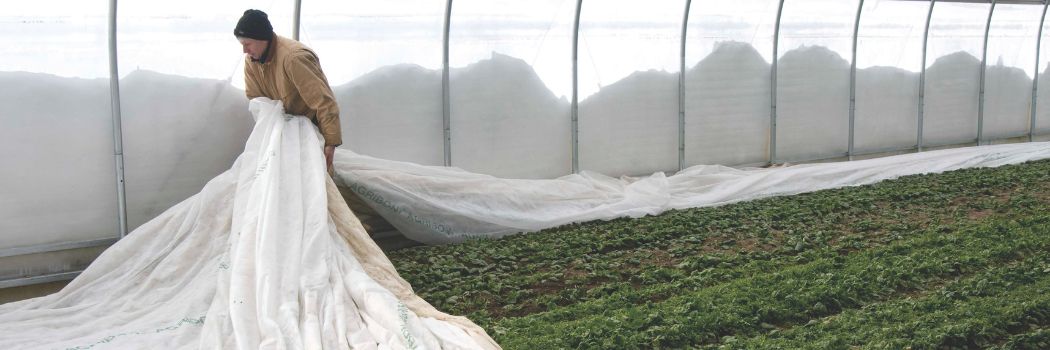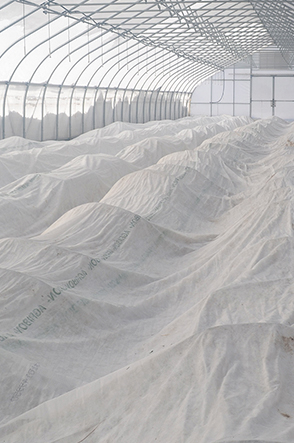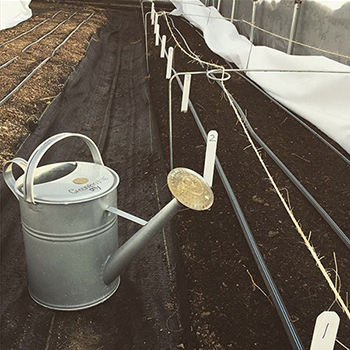- 10 Ways to Extend Your Season with Protected Cultivation
- QuickHoops Gothic High Tunnel Bender | Construction Manual for Modular Moveable Gothic High Tunnel (PDF)
- QuickHoops Gothic High Tunnel Bender | Construction Manual for Stationary Gothic High Tunnel (PDF)
- QuickHoops High Tunnel Bender | Construction Manual for Building a Stationary High Tunnel (PDF)
- QuickHoops Low Tunnel Benders | Instruction Manual (#9377 & #9520) | (PDF)
- Agribon+ AG-19, 30, 50 & 70 Row Cover | Insert (PDF)
- Hitch Mount for QuickHoops Low Tunnel Benders | Instruction Manual (PDF)
- Bobcat Automatic Ventilation Kit Manual (#6791) | Tech Sheet (PDF)
- Bobcat Pro High Tunnel Kit Manual (#6794) | Tech Sheet (PDF)
- Bobcat Pro High Tunnel Kit (#6794) | Parts List (PDF)
- Bobcat Sliding Door Kit Manual (#6792) | Tech Sheet (PDF)
- Bobcat Standard High Tunnel Kit Manual (#6795) | Tech Sheet (PDF)
- Bobcat Standard High Tunnel Kit (#6795) | Parts List (PDF)
- Bobcat Steel End Wall Kit Manual (#6793) | Tech Sheet (PDF)
- Truss Support Kit Manual (#6790) | Tech Sheet (PDF)
- Bobcat Tunnel Kits | Comparison Chart
- Beginning & Intermediate Controlled Environment Agriculture (CEA) | Advances in Greenhouse Crop Production
- 5 Cool Flowers to Plant Now | Lisa Mason Ziegler's Secrets for Growing Hardy, Cool-Season Annuals
- Hoop Loops | Installation Instructions | Tech Sheet (PDF)
- Introduction to Overwintering Flowers | Guide to Overwintering Flowers
- Overwintering Perennial Herbs
- Protect Your Crops | High & Low Tunnel Basics
- The Effect of Shorter Daylength on Winter Production
- Be First & Last to Market by Extending Your Growing Season
- Quick Hoops Low Tunnels | Set-up & Management with Eliot Coleman
- Constructing the Modular Moveable Gothic Tunnel – Animated Schematic
- Moving the Modular Moveable Gothic Tunnel – Slideshow
- Skinning the Modular Moveable Gothic High Tunnel – Slideshow
- Overwinter Flower Trials | Multiyear Results for 30+ Crops | Johnny's Selected Seeds | XLSX
- Seeding Date Calculator | Johnny's Recommended Flowers for Overwintering | XLSX
- Overwintering Onions from Seed | Johnny's Selected Seeds
- Winter Growing Guide | Part 5: Overwintering Planting Dates
- Pest & Disease Control Basics in Greenhouse, Hydroponic & Other Protected-Culture Systems
- Pests & Diseases of Greenhouses & Hydroponic Systems | Tech Sheet (PDF)
- Why & What to Grow in a Greenhouse? Basics of Protected Culture
- Recommended Varieties from Our Greenhouse Trials | What We Look for in Greenhouse Crops
- QuickHoops 3'W x 4.5'H Low Tunnel Bender (#7616) | Instruction Manual (PDF)
- Cable Purlin Trellis for QuickHoops High Tunnels | Installation Manual (PDF)
- QuickHoops Moveable High Tunnel Bender | Instruction Manual (PDF)
- QuickHoops Seedling & Microgreens Bench | Construction Guide (PDF)
- Row Cover & Insect Netting Options & Uses | Comparison Chart (PDF)
- Tufflite IV Greenhouse Film | Comparison Chart (PDF)
- Univent Automatic Opener for BiFold Doors | Instruction Manual (PDF)
- Video: Johnny's Season Extension & Overwintering Trials
- Video: Planning & Planting the Autumn Vegetable Garden | Tips & Recommendations with Niki Jabbour
- Video: Growing Under Cover with Niki Jabbour | Johnny's Webinar Series
- Video: Veggie Remix: Bring New Flavors & Colors Into Your Garden | Johnny's Webinar Series
- Video: Cover Cropping for Field & Garden with Collin Thompson | Johnny's Webinar Series
- Video: DIY Cold Frame • Easy How-to Tutorial with Niki Jabbour
- Video: Tips & Crop Recommendations for the Autumn and Winter Cold Frame • Tutorial with Niki Jabbour
- Video: How to Use Quick Hoops™ Benders to Create High & Low Tunnels
- Video: The Benefits of Row Covers | Recommendations & Tips
- Video: Hoop Houses & Other Ways to Extend Your Growing Season
- Video: Take a Tour with Us of Johnny's Greenhouses!
- Growing Under Cover with Niki Jabbour & Johnny's | Johnny's Educational Webinar Resources
- Johnny's Winter Growing Guide | Printable Brochure (PDF)
- Winter Growing Guide | Part 2: Production in the High Tunnel
- Winter Growing Guide | Part 1 - Introduction
- Winter Growing Guide | Part 3: Overwintering in Low Tunnels
- Winter Growing Guide | Part 6: Recommended Crops & Varieties
- Winter Growing Guide | Part 4: Planting Dates for a Winter Harvest
- When to Start Seeds for Overwintered Flowers | Guide to Overwintering Flowers
- Choosing Flower Crops to Overwinter | Guide to Overwintering Flowers
- Video: Winter Sowing & Milk-Jug Greenhouses | With Niki Jabbour & Johnny's
- Video: Irrigation Considerations for the Overwinter Flowers Tunnel | Johnny's Selected Seeds
- Webinar Slide Deck | Overwintering Flowers | 41-pp PDF
- Gardening in a Cold Frame With Niki Jabbour
Winter Production in the High Tunnel
Winter High Tunnel Fundamentals
“An important point is selecting correct varieties for winter growing. Another one is that watering is a big challenge. It is easy to overwater or underwater in the winter, so some of Johnny's tools like the moisture meter are important….
“Plants in high tunnels need air in winter, just as they do in summer… Fungus and/or aphid problems can develop if you do not provide good air circulation and venting of the high tunnel during the day. Also, heat management is more difficult by nature… We think, 'Well, it's cold outside; I won't go check the tunnels until 8 or so.' Then you realize the sun has been out for a couple of hours and the temp inside has gone from 25 to 75 and rising—and that is not what greens and lettuces like!
“Also important is having lots of organic matter in the soil, which leaves more air pockets in the soil, versus a solid block of frozen soil…
“Remember: in winter, high tunnels are your most expensive real estate, and you should consider all the costs vs. the returns of winter crops.”
—Jill Rendleman • All Seasons Farm • Cobden, Illinois
Fundamental structural principals of high tunnel design need to be observed to build a tunnel that will survive snow load, capture optimal sunlight, and allow for regulating heat and humidity when necessary. To learn more, get connected with your local cooperative extension service, educational institutions, and regional grower organizations. There are numerous forums, learning events, online resources, grant programs, and other initiatives available through these and other entities.
Winter Blankets
To achieve sufficient crop protection at higher latitudes, a well-proven strategy is to place one or more layers of row cover over the crops inside the tunnel in colder months. Row cover in a variety of weights and fabrics can be used in a multitude of configurations that differ between regions, farms, and microclimates. Lighterweight covers are sometimes left in place all the time. Other growers leave the crop covered at night and remove it on warmer days when the tunnel's internal temperature has risen sufficiently, a practice which results in increased solar gain and ventilates excess moisture that can encourage diseases common to winter tunnels, such as downy mildews of spinach and lettuce.
With some crops, the row cover can be laid directly on top of the crop. With others, some form of supportive structure is required, especially if multiple layers or heavier fabrics are used. From QuickHoops™ and wire wickets to cables and metal suspension frames, various components can be deployed to support row cover and make the daily process of removal for heat and humidity regulation more efficient.
Acclimating Plants to the Cold
From planting time all the way through winter, your plants will need to be able to acclimate to cooler temperatures and temperature cycles to prevent shock and necrosis. This adaptive process is similar to what plants undergo as you harden them off in the spring, before transplanting them out, except you are heading into cooler temperatures rather than warmer ones. To effectively accomplish this for winter, provide the plants with exposure to temperatures close to freezing, 32°F (0°C), with increasing duration and frequency. This can be done with careful temperature monitoring, so you know when to remove row cover or roll up the sides of the tunnel, or both. If you roll up the tunnel sides, keep a close eye on the weather for conditions that might cause damage to the plants, such as driving wind, rain, sleet, or snow.
Whether going into or coming out of winter, keeping your high tunnel warm is not as essential as preventing dramatic temperature fluctuations. The key is to maintain as steady a temperature, or as even a gradation of change, within the tunnel as possible, to reduce stress on the plants. Disease pressure can develop if you do not provide good air circulation and venting of the high tunnel during the day.
After becoming properly acclimated, the cold-hardy plants should be able to tolerate a solid freeze. Remember that the plants must be completely thawed before harvesting them, however. You may need to wait until the tunnel warms up, or provide supplemental heat, on harvest days.
Watering & Fertility
Thorough watering is necessary to get crops started, but they will generally require very little additional water during the season until such time as daylength again reaches 10 hours and growth resumes. Watering early in the day when the sun is out gives the plants and soil time to dry, minimizing conditions conducive to the development of disease. Use a moisture meter to avoid over- or under-watering.
If you need to apply fertilizer, use mild, low-impact sources. Without the leaching action of natural precipitation within the tunnel, salt build-up can become a problem. Some growers use overhead irrigation to "rinse" the salts from the soil. Others periodically leave their tunnels fallow and uncovered, to allow rains to leach the salt.




